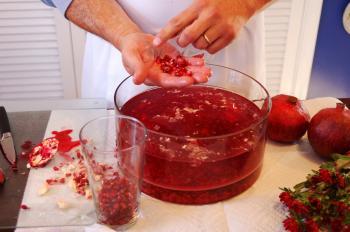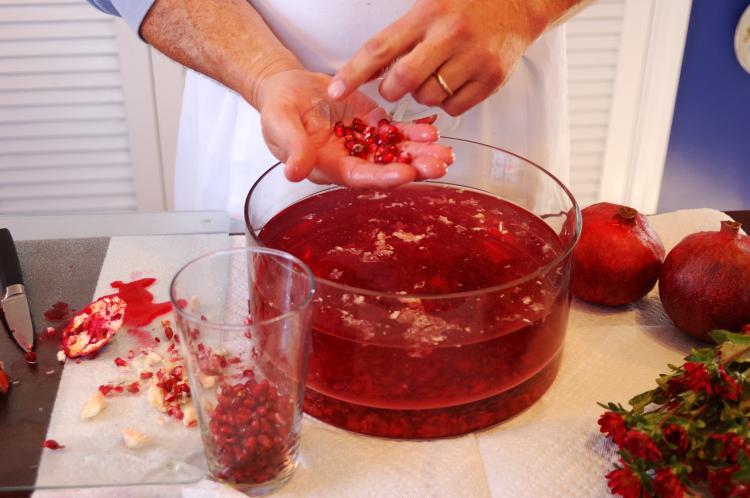“About a decade ago researchers in Israel confirmed some extraordinary attributes of pomegranate including high levels of antioxidants for well being,” says Tom Tjerandsen, the manager of the Pomegranate Council. As this knowledge began to increase, growers began to plant more acreage. Previously, “pomegranates were used for fall cornucopia displays and then swiped into the trash, and rarely eaten.”
Today there has been an explosion of pomegranates in the market. This comes from increases in production and culinary trends set by the food service industry, Tjerandsen explains. This includes ways to decorate food with pomegranate seeds and for taste.
Tjerandsen suggests adding an ice cube made from pomegranate juice and a few seeds to your favorite carbonated drink. As the ice melts, the red pomegranate juices spiral through the drink.
Although pomegranates can be a pretty intimidating fruit to work with due to it’s unique structure, it is actually incredibly tasty. It is both sweet and tart, while being beautiful and bright.
This flesh fruit contains some 840 red juicy seeds called arils. Be aware that the juice of the arils stains anything it comes into contact with. Deseeding is fairly easy after making yourself and area protected from the juice.
First, cut the top part off of the pomegranate and slice the outer skin of the fruit into fourths. The work is done under cold water in a bowl to minimize the mess and to speed up the deseeding process. Turn the seed part down into the bowl and push out the seeds. Collect the seeds that have settled to the bottom of the bowl. Discard the white membrane that floats on the water and sticks to the seeds. The seeds can be frozen for later use or kept in the refrigerator for a period of time.
You may juice the fleshy seeds by putting them in a plastic bag and smashing them (or pomegranate juice may be purchased in many grocery stores today).
Pomegranates are picked ripe from August to mid November and are available until January in stores.
Roasted Salmon with Pomegranate and Avocado Salsa
2 teaspoons ground coriander
2 teaspoons sugar
Salt, as needed
1 pomegranate, seeded
1/2 cup thinly sliced green onion
3 tablespoons fresh lime juice
2 teaspoons finely chopped jalapeno pepper or to taste
1 large clove garlic, chopped finely
2 avocados, preferably Hass, diced into 1/2-inch pieces
1 heart of romaine, about 7 ounces
4 center-cut salmon fillets the same thickness, 6 to 7 ounces each
1 lime cut in eighths for garnish
Mix coriander, sugar, and salt—reserve.
Up to four hours before serving, mix pomegranate seeds, onion, lime juice, jalapeno, and garlic; gently fold in avocado. If holding more than 30 minutes, put plastic wrap against the surface of the salsa, then tightly cover; store in the refrigerator. Remove about 30 minutes before serving.
Separate the romaine leaves; wash, then dry thoroughly. Reserve four of the most attractive leaves for garnish. Slice the remaining leaves crosswise in thin shreds; reserve.
To prepare the salmon, rub a generous teaspoon of the reserved seasoning mixture over each piece. Arrange the salmon on a baking sheet, skin-side down. Roast at 500 degrees Fahrenheit for about 11 minutes for medium rare (salmon should be spongy when pressed with a finger at its thickest part) and 13 minutes for medium-well (salmon should be just firm when pressed with a finger at its thickest part).
While the salmon cooks, mound 1/4 of the shredded romaine on each of four serving plates. Top with 1/2 cup of salsa. When salmon is done, let it cool slightly—it should be warm but not hot. Put a piece of salmon on each plate; garnish each with a reserved romaine leaf and two lime wedges.
Makes four servings.
This recipe is courtesy of the Pomegranate Council. Their Web site is http://www.pomegranates.org.







